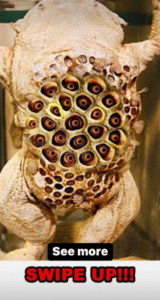The Surinam Toad: Nature’s Strangest Amphibian
The Surinam toad (Pipa pipa) might just be one of the most bizarre—and fascinating—creatures in the animal kingdom. Native to the slow-moving waters of the Amazon Basin and other parts of northern South America, this aquatic amphibian is famous (and infamous) for its strange appearance and its even stranger reproductive habits.
To start, the Surinam toad doesn’t look much like your average frog. Its body is flat and squarish, with a mottled, brownish-gray skin that blends in with muddy waterbeds. It has no tongue and no teeth. Its eyes are small and set high on its triangular head. The toad is nearly motionless much of the time, relying on camouflage to avoid predators. At first glance, it might look more like a wet, dead leaf than a living animal. But it’s very much alive—and what it does next is straight out of science fiction.
What truly sets the Surinam toad apart is its surreal method of reproduction.
When it’s time to mate, the male and female rise to the water’s surface. As the female releases eggs, the male fertilizes them and presses them into the female’s back. Over the course of a few hours, the eggs are absorbed into the skin, where individual pockets form around each one. These tiny chambers will serve as the toadlets’ incubation space for the next several weeks.
That’s right—the Surinam toad is essentially a living incubator.
Inside the mother’s back, the eggs grow and develop into fully formed toads. Unlike most amphibians that go through a tadpole stage, these babies bypass it entirely. After about three to four months, they erupt—literally—from their mother’s back, crawling out one by one. It’s a disturbing yet incredible sight. Tiny toads burst from the skin, leaving behind crater-like holes that eventually heal.
This grotesque beauty is not a health hazard to the mother; her skin is specially adapted for this function. However, the visual has often shocked viewers unfamiliar with nature’s weirder reproductive strategies. Videos of this process have gone viral, simultaneously amazing and horrifying people.
The Surinam toad’s entire life is aquatic. It uses star-shaped tips on its fingers—called tactile organs—to sense food in murky waters. Because it can’t croak (it has no vocal cords), it communicates with sharp clicking sounds by snapping a bone in its throat, especially during courtship.
Though not endangered, Surinam toads are not often seen due to their secretive nature and preference for still, leaf-littered water. They serve as a reminder that evolution can take creatures in very unexpected directions.
In short, the Surinam toad is one of those animals that make you wonder just how diverse and bizarre life on Earth really is. Equal parts strange and stunning, this flat-bodied amphibian is living proof that when it comes to nature, truth is often stranger than fiction.

